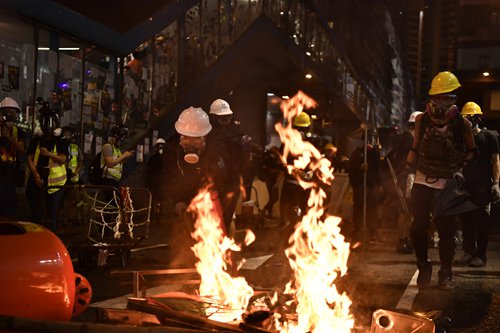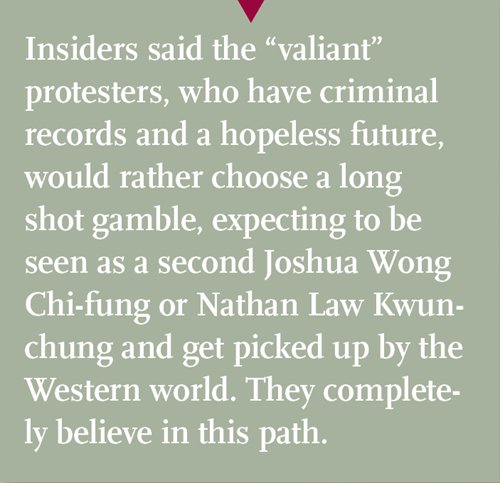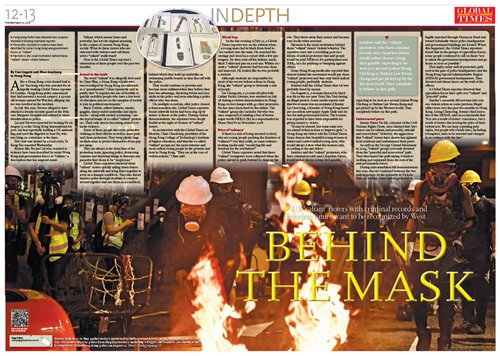HOME >> CHINA
HK ‘valiant’ rioters with criminal records and hopeless future want to be recognized by West
By Fan Lingzhi and Zhao Juecheng Source:Global Times Published: 2019/8/21 18:08:40
○ Hong Kong Police have detained two suspects involved in beating mainland reporter
○ Those who resorted to violence have been described by some Hong Kong anti-government forces as "valiant"
○ Payment is the usual motivation behind these "valiant" rioters' violent behavior

After a Hong Kong court denied bail to Lai Yun-long, who was arrested for allegedly beating Global Times reporter Fu Guohao, Hong Kong police announced they had arrested a second suspect, a 23-year-old woman named Pat Wai-fun, alleging she too was involved in the incident.
In July this year, Pat was alleged to have attacked a female security guard at the Princess Margaret Hospital and refused to show identification to police.
Lai and Pat were arrested for beating Fu on August 13 at the Hong Kong International Airport. Lai was reportedly holding a US national flag and used the flagstick to beat Fu, who was lying on a stretcher at the time.
Pat's bail was denied by a local court, Ta Kung Pao reported Wednesday.
Rioters like Pat and Lai who resorted to violence have been described by some Hong Kong anti-government forces as "valiant," a description that has angered many.
Valiant, which means brave and powerful, has lost its original meaning in the context of current Hong Kong society. What do these rioters who are obsessed with violence and call themselves "valiant" really want?
Here is the Global Times reporter's observation of these people over the past two months.
Armed to the teeth
The word "valiant" was allegedly first used by Chan Wan, a Hong Kong scholar who was worshiped by Hong Kong secessionists as a "grandmaster." Chan reportedly said in public that "it requires the use of hostility to quickly mobilize people who have a low level of education and are on the margins of society to join in political movements."
Black T-shirts, yellow helmets, masks, goggles, sharp-ended umbrellas and alpenstocks - along with excited screaming - are the typical image of so-called "valiant" protesters. Their only aim in becoming armed is to incite violence.
Some of these people also wear protective clothing on their elbows as well as knee pads and chest protectors. They wrap plastic bags on their arms to protect themselves from pepper spray.
They are always at the front line of the protesting team, ignoring police, destroying cameras and throwing things to threaten any passerby they deem to be "suspicious."
Global Times reporters observed these "valiant" rioters quickly taking down fences along the sidewalk and tying three together to serve as a triangle roadblock. They also thrust bamboo poles through dustbins to connect several together and use them as a roadblock, behind which they hold up umbrellas or swimming paddle boards as they face-off with the police.

They would continue to provoke and become more militant when they believe they have the advantage, throwing bricks and iron sticks at the police and even attacking a police officer who was alone.
On multiple occasions, after police cleared a demonstration site, Global Times reporters found sidewalk bricks had been dug up by rioters to throw at the police. During violent demonstrations, the reporters were deeply fearful at the sight of clusters of "valiant" rioters.
In an interview with the Global Times on Monday, Chan Cheuk-hay, president of the Hong Kong College of Technology's institute of higher education, said that the so-called "valiant" groups are the most extreme and most radical young people in the protests and riots in Hong Kong. "They are at the core of violent actions," Chan said.
Mixed bag
In the late evening of July 21, a Global Times reporter was on the subway when a young man clad in black from head to toe rushed onto the train. He searched the carriage and stood in a corner with a few passengers. He then took off his helmet, mask, black T-shirt and put on a red one. Within seconds a "valiant" protester had become clean and innocent. He looked like he was probably a student.
Although students are responsible for most of the recent violent actions in Hong Kong, the "valiant" group is obviously a mix of people.
Liu Chung-yin, a 30-year-old pilot with Cathay Pacific Airways, was arrested on July 28 during a violent demonstration in Hong Kong on riot charges with 43 other protesters. He has since been fired by the airline. The "valiant" group also includes Pat who was once suspected of stealing a box of brown sugar worth HK$7.6 ($1) in a supermarket in Sham Shui Po in November 2018.
Price of 'valiance'
If there's a risk of being arrested or fired, why are young people pushing the frontiers of "valiance"? Are they really, as some violence-inciting media said, "sacrificing life and freedom for the revolution?"
Global Times reporters noted that these "valiant" youngsters soon collapsed when the police started to push forward to clean up the site. They threw away their armor and became very docile when arrested.
Payment is the usual motivation behind these "valiant" rioters' violent behavior. The reporters once saw a recruiting post on a forum of radical protesters that said people would be paid HK$600 for participation and HK$3,000 for pushing or bumping against others.

Insiders told the Global Times that Lai was probably lured by money.
On August 11, a woman dressed in black was hit in the eye near Tsim Sha Tsui during an illegal protest. Some media reports said that the woman was an assistant of Jimmy Lai Chee-ying, a founder of Hong Kong-based pro-secession newspaper Apple Daily and donor for anti-government forces. The woman was reported to have been responsible for giving money to rioters.
"It may be absurd, but some male rioters attend violent actions to impress girls," a Hong Kong taxi driver told the Global Times. Some donors hire beautiful young women to attract and control radical young men, who would always follow what the women said, according to the taxi driver.
Insiders said the "valiant" protesters, who have criminal records and a hopeless future, would rather choose a long shot gamble, expecting to be seen as a second Joshua Wong Chi-fung or Nathan Law Kwun-chung and get picked up by the Western world. They completely believe in this path.
Embarrassed peers
Jimmy Sham Tsz-kit, convener of the Civil Human Rights Front, once claimed that "protesters can be valiant, and peaceful, rational and non-violent." However, the aggression that "valiant" rioters have shown has agitated local residents and embarrassed their peers.
As early as the Occupy Central Movement in 2014, "valiant" groups seriously deviated from the "peaceful and non-violent" path. They denounced the path saying it leads to nothing and separated from the rest of the anti-government forces.
During anti-extradition bill demonstrations this year, discord continued between the two radical groups. At the assembly in Victoria
Park on Sunday, some radical protesters illegally marched through Hennessy Road and toward Admiralty where police headquarters and government buildings are located. When this happened, the Global Times reporters found that in the groups of opposition forces, some people continued to call on them "not to attack the government headquarters and go home as soon as possible."
That night, many radical protesters gathered at the gate of police headquarters and the Hong Kong Special Administrative Region (HKSAR) government headquarters. They shouted and shone lasers on the wall of the offices.
A Global Times reporter observed that opposition forces have split over "valiant" and "peaceful" paths.
Sunday's assembly did not turn into serious violent action as some previous illegal rallies have over the past two months in Hong Kong. Leung Chun-ying, former chief executive of the HKSAR, said on social media that "it is not a result of rioters' conscience, but a result of rioters discovering the price of their violent acts. We can keep repeating principles, but people who violate laws, including youngsters, have to be arrested and charged in accordance with the law."

Newspaper headline: Behind the mask
○ Those who resorted to violence have been described by some Hong Kong anti-government forces as "valiant"
○ Payment is the usual motivation behind these "valiant" rioters' violent behavior

Rioters light fires as they gather in the Causeway Bay MTR station in Hong Kong on August 4. Photo: AFP
After a Hong Kong court denied bail to Lai Yun-long, who was arrested for allegedly beating Global Times reporter Fu Guohao, Hong Kong police announced they had arrested a second suspect, a 23-year-old woman named Pat Wai-fun, alleging she too was involved in the incident.
In July this year, Pat was alleged to have attacked a female security guard at the Princess Margaret Hospital and refused to show identification to police.
Lai and Pat were arrested for beating Fu on August 13 at the Hong Kong International Airport. Lai was reportedly holding a US national flag and used the flagstick to beat Fu, who was lying on a stretcher at the time.
Pat's bail was denied by a local court, Ta Kung Pao reported Wednesday.
Rioters like Pat and Lai who resorted to violence have been described by some Hong Kong anti-government forces as "valiant," a description that has angered many.
Valiant, which means brave and powerful, has lost its original meaning in the context of current Hong Kong society. What do these rioters who are obsessed with violence and call themselves "valiant" really want?
Here is the Global Times reporter's observation of these people over the past two months.
Armed to the teeth
The word "valiant" was allegedly first used by Chan Wan, a Hong Kong scholar who was worshiped by Hong Kong secessionists as a "grandmaster." Chan reportedly said in public that "it requires the use of hostility to quickly mobilize people who have a low level of education and are on the margins of society to join in political movements."
Black T-shirts, yellow helmets, masks, goggles, sharp-ended umbrellas and alpenstocks - along with excited screaming - are the typical image of so-called "valiant" protesters. Their only aim in becoming armed is to incite violence.
Some of these people also wear protective clothing on their elbows as well as knee pads and chest protectors. They wrap plastic bags on their arms to protect themselves from pepper spray.
They are always at the front line of the protesting team, ignoring police, destroying cameras and throwing things to threaten any passerby they deem to be "suspicious."
Global Times reporters observed these "valiant" rioters quickly taking down fences along the sidewalk and tying three together to serve as a triangle roadblock. They also thrust bamboo poles through dustbins to connect several together and use them as a roadblock, behind which they hold up umbrellas or swimming paddle boards as they face-off with the police.

Weapons seized by police from illegal protesters, including a dagger and hammer, are shown at the headquarters of the Hong Kong police on August 12. Photo: Chen Qingqing/GT
They would continue to provoke and become more militant when they believe they have the advantage, throwing bricks and iron sticks at the police and even attacking a police officer who was alone.
On multiple occasions, after police cleared a demonstration site, Global Times reporters found sidewalk bricks had been dug up by rioters to throw at the police. During violent demonstrations, the reporters were deeply fearful at the sight of clusters of "valiant" rioters.
In an interview with the Global Times on Monday, Chan Cheuk-hay, president of the Hong Kong College of Technology's institute of higher education, said that the so-called "valiant" groups are the most extreme and most radical young people in the protests and riots in Hong Kong. "They are at the core of violent actions," Chan said.
Mixed bag
In the late evening of July 21, a Global Times reporter was on the subway when a young man clad in black from head to toe rushed onto the train. He searched the carriage and stood in a corner with a few passengers. He then took off his helmet, mask, black T-shirt and put on a red one. Within seconds a "valiant" protester had become clean and innocent. He looked like he was probably a student.
Although students are responsible for most of the recent violent actions in Hong Kong, the "valiant" group is obviously a mix of people.
Liu Chung-yin, a 30-year-old pilot with Cathay Pacific Airways, was arrested on July 28 during a violent demonstration in Hong Kong on riot charges with 43 other protesters. He has since been fired by the airline. The "valiant" group also includes Pat who was once suspected of stealing a box of brown sugar worth HK$7.6 ($1) in a supermarket in Sham Shui Po in November 2018.
Price of 'valiance'
If there's a risk of being arrested or fired, why are young people pushing the frontiers of "valiance"? Are they really, as some violence-inciting media said, "sacrificing life and freedom for the revolution?"
Global Times reporters noted that these "valiant" youngsters soon collapsed when the police started to push forward to clean up the site. They threw away their armor and became very docile when arrested.
Payment is the usual motivation behind these "valiant" rioters' violent behavior. The reporters once saw a recruiting post on a forum of radical protesters that said people would be paid HK$600 for participation and HK$3,000 for pushing or bumping against others.

Some Hong Kong media also reported that donors behind the movement would pay these "valiant" protesters and they only hired radical young people, preferably students.
Insiders told the Global Times that Lai was probably lured by money.
On August 11, a woman dressed in black was hit in the eye near Tsim Sha Tsui during an illegal protest. Some media reports said that the woman was an assistant of Jimmy Lai Chee-ying, a founder of Hong Kong-based pro-secession newspaper Apple Daily and donor for anti-government forces. The woman was reported to have been responsible for giving money to rioters.
"It may be absurd, but some male rioters attend violent actions to impress girls," a Hong Kong taxi driver told the Global Times. Some donors hire beautiful young women to attract and control radical young men, who would always follow what the women said, according to the taxi driver.
Insiders said the "valiant" protesters, who have criminal records and a hopeless future, would rather choose a long shot gamble, expecting to be seen as a second Joshua Wong Chi-fung or Nathan Law Kwun-chung and get picked up by the Western world. They completely believe in this path.
Embarrassed peers
Jimmy Sham Tsz-kit, convener of the Civil Human Rights Front, once claimed that "protesters can be valiant, and peaceful, rational and non-violent." However, the aggression that "valiant" rioters have shown has agitated local residents and embarrassed their peers.
As early as the Occupy Central Movement in 2014, "valiant" groups seriously deviated from the "peaceful and non-violent" path. They denounced the path saying it leads to nothing and separated from the rest of the anti-government forces.
During anti-extradition bill demonstrations this year, discord continued between the two radical groups. At the assembly in Victoria
Park on Sunday, some radical protesters illegally marched through Hennessy Road and toward Admiralty where police headquarters and government buildings are located. When this happened, the Global Times reporters found that in the groups of opposition forces, some people continued to call on them "not to attack the government headquarters and go home as soon as possible."
That night, many radical protesters gathered at the gate of police headquarters and the Hong Kong Special Administrative Region (HKSAR) government headquarters. They shouted and shone lasers on the wall of the offices.
A Global Times reporter observed that opposition forces have split over "valiant" and "peaceful" paths.
Sunday's assembly did not turn into serious violent action as some previous illegal rallies have over the past two months in Hong Kong. Leung Chun-ying, former chief executive of the HKSAR, said on social media that "it is not a result of rioters' conscience, but a result of rioters discovering the price of their violent acts. We can keep repeating principles, but people who violate laws, including youngsters, have to be arrested and charged in accordance with the law."

Newspaper headline: Behind the mask